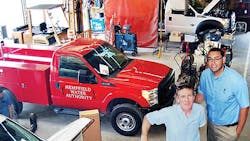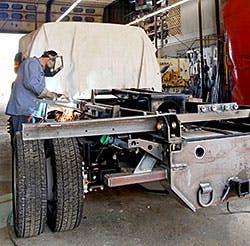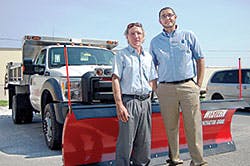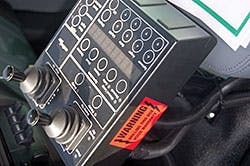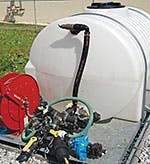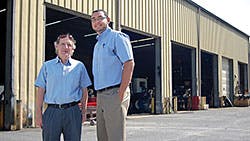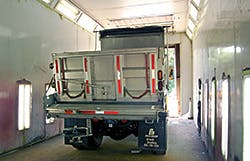Lancaster Truck Bodies expects demand for equipment after epic snow-and-ice nightmare
IT was a crazy-busy, ultra-profitable, super-rewarding winter for Lancaster Truck Bodies.
And even though nobody can promise that central Pennsylvania will be once again battered by historic, out-of-nowhere snowfall events and worst-of-the-decade ice storms, vice president/general manager Luis Olmeda and new owner Paul Statler are certain that it will be busy and profitable.
“There is going to be some pent-up demand because of what didn’t happen last year,” Statler says. “At the end of the winter season, there was still a lot of equipment that hadn’t been fixed. We hopefully are going to see that early in the season this winter. It happens every time: If you have a hard winter, the busy times are the following fall. If it doesn’t snow, then you bring your inventory down the next fall because you know you won’t have that peak. But our history would say there is going to be demand in the fourth quarter of this year.”
Says Olmeda, “Even if we don’t have good snowfall this winter, they have to pay for their sins of last year. They really do. They have to get back to where they were at the beginning of last year, wherever that was at.”
He says Lancaster Truck Bodies—a National Truck Equipment Association “MVP” distributor and a bailment pool for GMC and Chevrolet—experienced a significant increase in parts sales and repairs in the shop, but most customers were too busy dealing with the scourge of winter to buy new equipment.
“We’ll see a surge this fall for new equipment,” he says. “I’d imagine a lot of companies that were postponing will have to make some purchases. There were budget constraints. A lot of municipalities had money set aside for new equipment, and that got put on the chopping block and they kicked the can down the road. Now they can’t kick it any farther. We noticed a lot of things that usually don’t go bad were going bad, so now they have no other choice.”
Last winter was nothing like 1958, when from March 18-21, two to three feet of snow fell across higher terrains of Lancaster County and 50 inches inundated the area around the Morgantown exchange of the PA Turnpike. It also wasn’t a repeat of February 10, 2010, when two feet of snow fell, giving the area four feet in a five-day span.
But it was pretty darned severe.
Fourteen inches fell in December, the second-most since they started keeping records in 1977.
In January, 16.8 inches accumulated in Lancaster city, the second-most since 2000. Ice was a huge problem, with the lowest average minimum temperature (14.7 degrees) since 1994 (13.7).
In February, they were rocked by 28.6 inches of snow, the second-most since 1977. That included 16 inches in a 24-hour period. The average minimum temperature of 18.7 was the second-lowest since 1993 (18.5).
And a dramatic ice storm on February 5 knocked out power to more than 50,000 PPL electric customers, some of whom didn’t have power for three days. It was so bad that the White House declared the county a disaster area, making it eligible to apply for Federal Emergency Management Agency aid.
And it wasn’t over just yet. March had the coldest average minimum temperature ever (24.5).
“It seemed like every two or three days, we had something—whether it was snow or ice or slush,” Olmeda says. “It started in December and didn’t let up until March. We even had a little bit of snow in April—kind of a freak storm, no one expecting it. It was long, brutal, cold winter.
“But it was good for business. Plows and spreaders are what took the beating. When you have over six inches of snow, guys can’t see what’s on the road, so they’re beating the heck out of those things. We were selling lots of quadrants, cutting edges.”
Says Statler, “We had the kind of snows last year where there’s a lot of damage. When you have six inches of snow, that’s usually ‘damage snow.’ They can’t see the hazards. When you put a piece of metal in front of a truck and customers hit things, it’s very obvious. Those types of snows create the parts business. The couple-of-inches snows, the nuisance snows, don’t create much parts business. But we had a lot of non-nuisance snows. Some years, you just get two inches here, two inches there. It’s still good for our business, but it’s not the kind of snows like last year, when we had a lot of damage.”
Supply shortage
Lancaster Truck Bodies couldn’t keep up. Not because it wasn’t ready, but because the nightmarish winter affected a large portion of the cold-weather states and dramatically drained the inventory of the national suppliers.
“Our manufacturers, Western for sure, tend to have enough inventory to cover a normal winter for the nation,” Statler says. “When the whole nation gets under a terrible winter like last year, parts availability becomes less and less. And by time we got into February, there just wasn’t much left.
“Last year, everybody was having winter events, even down into Georgia. So it was a tough year to get parts for us.”
Says Olmeda, “If it was able to be patched up and fabricated, we had got customers satisfied that way. If not, we either tried to source it elsewhere or if we couldn’t, people unfortunately had to live without. We weren’t happy and the customer wasn’t happy.”
Adds Statler, “You try to source it anywhere you can. But it gets to be limited. Every one of us in our business is doing the same thing when you’re having a winter like last year. There’s no way you get enough for everybody. You can’t plan for it. It is weather-dependent. You could be sitting on inventory for years if it doesn’t snow. It’s a tough business because it’s so cyclical.”
Over the past two winters, Lancaster Truck Bodies has experienced a 70% increase just in parts sales. Which has been critically important, because snow-and-ice control is huge at the company—it drives over half of the yearly revenue.
Lancaster Truck Bodies services all the dealerships, but the local municipalities are the biggest portion of its work. The bread-and-butter is central hydraulics for snowplows, dump bodies, and salt spreaders. The company is a distributor for Western and Viking-Cives (USA) plows, Smith spreaders, and Western spreaders. It can satisfy all needs, from light-duty pickup-truck plows to the biggest, heaviest airport plows and shelving wings; from tailgate-mounted pickup-truck hoppers, stainless-steel, under-tailgate spreaders to the largest stainless steel “V” Box spreaders; and it also carries a full line of liquid-calcium systems and brine-making machines.
Its bread-and-butter unit is a F550 diesel dump truck with plow, spreader and LTB Control Pro 6 central hydraulics.
Some of the features: pressure and flow-compensating front piston pump; Western 9-foot ProPlus snowplow; Galion 103U stainless steel dump body, Super Duty, with 18-inch sides and 24-inch gate; plow lights are custom-mounted and tilt forward so the truck hood can open; and a Smith stainless steel under-tailgate spreader.
“The Western plow is fully hydraulic,” Olmeda says. “It’s all operated off the controller inside the truck. The salt spreader and dump bed are fully hydraulic—all with simultaneous operation, which is what the customer needs. In a lot of cases, we run into customers who have been sold something by a competitor and they don’t get this. They get something where they have to stop the truck entirely to strike a function. The customer doesn’t want to hear that in the middle of a snowstorm. This is what the customer wants and needs.
“A lot of what we sell is 304 stainless with #4 finish. Although slightly softer than 201, realistically 304 is geared more for what they are using these trucks for with the materials they are spreading on the road. Customers keep coming back because we have the service and knowledge. They love everything we have to offer. We know we won’t win them all, but this is critical.
“Our salesmen do a good job of selling our package. We try to standardize our package. We find that if you get too custom out there, you don’t please everyone. We have a base package that customers like and that gets the job done.”
Out in the yard, Olmeda and Statler demonstrate a demo unit for New Holland Ford, one of its network dealerships. Olmeda says the company works with dealerships to put a demo together, which enables a faster turnaround for the township.
“You always have a municipality, or even commercial accounts, that need a truck right now,” Olmeda says. “Stainless is a big mover right now. A lot of municipalities realize they can take this stainless off after a 10-year cycle and put it on a new chassis and just roll with it.”
“Now, it’s 85% stainless,” Statler adds. “We sold more aluminum five years ago.”
Things also have changed with liquid treatment, which was rarely used 10 years ago but is now a popular item.
“The main reasons for the change are the material savings and the fact that it is a better application,” Statler says. “Some of the townships are saying they can save 75% of their salt budget if they use liquid. And that’s a big savings for them. The trend seemed to start in urban areas in eastern Pennsylvania. In western Pennsylvania, they use a lot of granular, but liquid is becoming more popular in all areas of the state. That’s definitely a trend in the snow-and-ice removal industry.”
Lancaster Truck Bodies has two salesmen on the road, knocking on the doors of municipalities. Most of them participate in COSTARS, the state’s cooperative purchasing program administered by the Department of General Services (DGS) Bureau of Procurement. COSTARS provides registered local public procurement units, state-affiliated entities, and suppliers a tool to find and do business with each other effectively through the use of a contract established by DGS.
“That’s big here,” Statler says. “It’s more or less like a piggyback program that allows municipal customers to buy what they want while avoiding the bidding process. It’s still competitive because they can buy from whoever’s on the COSTARS program and can price it from various distributors on COSTARS.
“It allows them to buy what they need. Most of our customers are knowledgeable about what they need. Before the COSTARS program, they had to write specifications, which required them to get an attorney and go through a bidding process, which required a lot of expense. Not only that, but if a competitor met the specs at a minimum, our customers might be forced to take something they didn’t really want. This allows them to buy what they want and from who they want to buy it from. I actually believe it’s a better thing for citizens and saves money. Just because something’s cheaper doesn’t mean you’re going to save money. There are a lot of valued-added products in our industry.”
The history
The company was started in 1936 by Orville Easton as Lancaster Automobile Spring Company in a small facility in Lancaster. After starting out primarily as a manufacturer of automobile springs and “U” bolts, it moved six years later into truck body sales and truck modifications.
In 1972, Ron Hill purchased the company from Easton and Richard Bomberger, sold the spring business to one of the employees, and changed the name to Lancaster Truck Bodies. Five years later, they moved to the current location on Richardson Drive.
In 1983, the first branch location was opened in Concordville, Pennsylvania. Twelve years later, the company opened a second branch in Kennett Square, Pennsylvania, roughly halfway between Lancaster and Philadelphia near the Delaware border.
In 2007, the company was purchased by Luis C Torres, president.
It remained under that ownership until Statler bought it in March. He viewed it as the perfect complement to his other business, US Municipal, which has three locations in Pennsylvania: King of Prussia, Huntingdon, and Evans City.
“US Municipal is a distribution company,” he says. “We are set up in a different way than Lancaster Truck Bodies: 20% of our business is truck upfits, and we have other products such as street sweepers, sewer, and other equipment, and signs and sign posts. Each segment makes up 20% of our business. As part of the recession, our industry started to slow down in 2008 and bottomed out in 2011. When it started to come back, it came back with truck upfits first. If you have to spend $300,000 on a street sweeper or $100,000 on a truck and you need them both, the first item you’re going to buy is a truck.
“US Municipal is limited by shop production space. We can only upfit so many trucks in a month. To increase capacity, we would have to add on to our existing facility. This business became available and has additional capacity. I can use Lancaster Truck Bodies to manufacture for US Municipal, and I can use US Municipal’s sales force to sell for LTB. I can grow both businesses without increasing my overhead. This became a perfect fit for me.”
Statler also was attracted by the company’s stability, history, and reputation.
“It’s one of the oldest and most established truck-body-upfit companies in the area,” he says. “They are one of the first to introduce central hydraulics to the area. They are certainly one of the ones that pioneered it in eastern PA.”
Before the recession, Lancaster Truck Bodies’ revenue was $8.1 million per year. It’s now at $5.5 million, but the arrow is pointing up.
“This place is great because we can grow without expanding the facility,” he says, referring to the 10,000-square-foot facility that sits on five acres. “There’s no question about that. That was what I wanted the most.
“Lancaster provides product that US Municipal does not have now. I’ll be able to sell their other product through US Municipal.”
There will be plenty of growth this winter, even if the weather doesn’t turn out to be as apocalyptic as it was last winter.
According to the Old Farmer’s Almanac, the winter in Lancaster County “will be much colder than normal, with slightly below-normal precipitation and snowfall. The coldest periods will occur in early to mid-December, from late December into early January, and in mid- and late- January. The snowiest periods will occur in mid-December and early February.”
“Chances are, we won’t get the same winter,” Olmeda says, “but who knows?” ♦
